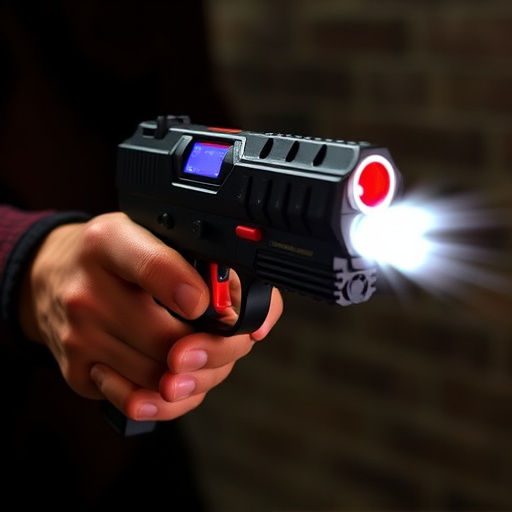Understanding concealed carry laws is critical for owning a Master Blaster stun gun, as regulations vary widely globally, with some regions allowing only qualified individuals or specific models. In the U.S., state-to-state rules differ significantly, necessitating thorough research to avoid legal issues and ensure safety. Responsible ownership requires knowledge of device functionality, training in tactical deployment and de-escalation, ethical use (as a last resort), and consideration of bystanders' rights, medical conditions, animals, and environmental impacts.
“Uncovering the regulations surrounding concealed carry stun guns is essential for those seeking self-defense options. This comprehensive guide, ‘Understanding Concealed Carry Laws,’ delves into the legal complexities of stun gun ownership and usage. We explore the ‘Master Blaster Stun Gun’—its features and legal standing—and navigate state-by-state regulations. Additionally, we emphasize responsible ownership by discussing safety, training, and ethical use. Stay informed and empowered with this detailed overview of stun gun regulations.”
- Understanding Concealed Carry Laws: A Comprehensive Overview
- The Master Blaster Stun Gun: Features and Legal Considerations
- State-by-State Regulations: Navigating the Complexities
- Safety, Training, and Ethical Use: Responsible Stun Gun Ownership
Understanding Concealed Carry Laws: A Comprehensive Overview
Understanding Concealed Carry Laws is essential when considering the possession of a master blaster stun gun. Each jurisdiction has its own set of rules and regulations, which can vary widely from state to state or even county to county. These laws cover various aspects, including who can carry, where it’s permitted, and what type of stun devices are legal. For instance, some regions allow only certain qualified individuals, such as off-duty law enforcement officers or licensed security professionals, to conceal and carry a stun gun. Others may have broader criteria but still impose restrictions on the power output and design of the device, ensuring it’s not overly dangerous while still providing a reasonable level of protection.
Navigating these regulations requires thorough research and staying informed about any changes. It’s crucial to check with your local law enforcement agencies or legal professionals specializing in firearms law for accurate, up-to-date information regarding concealed carry permits, restrictions, and the specific requirements for master blaster stun gun ownership. By understanding the laws, you can ensure compliance and avoid potential legal issues, fostering a safer environment for all.
The Master Blaster Stun Gun: Features and Legal Considerations
The Master Blaster Stun Gun is a powerful and popular choice among those seeking a concealed carry option for personal protection. This stun gun packs a significant punch, delivering high voltage shocks that can disable an attacker instantly. Its sleek design allows for easy concealment, making it an appealing option for individuals who want to be prepared in case of emergencies without drawing unnecessary attention. The device typically features a simple activation mechanism, such as a trigger or thumb-operated switch, ensuring quick deployment when needed.
Legally, the Master Blaster Stun Gun falls under specific regulations that vary across jurisdictions. In many states, stun guns are classified as less-lethal weapons and are subject to permit requirements. Users must ensure they meet the necessary criteria, such as age restrictions and completion of training courses, to legally carry a stun gun. Additionally, there might be rules regarding the type of voltage and power output allowed, as well as specific areas where stun guns are prohibited, like schools, government buildings, or airports. It’s crucial for prospective buyers to research and understand these regulations to ensure compliance and avoid legal repercussions.
State-by-State Regulations: Navigating the Complexities
In the United States, regulations surrounding concealed carry stun guns, also known as master blasters, vary significantly from state to state. This creates a complex landscape for individuals seeking to exercise their right to self-defense while adhering to local laws. Some states have liberalized regulations, allowing for concealed carry of stun guns with minimal restrictions, while others maintain stringent requirements or outright ban their possession.
Navigating these complexities involves thorough research into specific state laws and local ordinances. States like Texas and Florida generally allow the open and concealed carry of stun devices without a permit, whereas states like New York and California have strict regulations, often requiring permits and specific models approved by local authorities. Understanding these variations is crucial for responsible gun ownership and ensuring compliance with the law.
Safety, Training, and Ethical Use: Responsible Stun Gun Ownership
The responsible ownership of a master blaster stun gun involves more than just legal compliance; it’s a commitment to safety, training, and ethical use. Before deploying any stun device, including powerful master blaster stun guns, owners should thoroughly understand their functionality, range, and stopping power. Beyond basic operation, specialized training in tactical deployment, de-escalation techniques, and the legal implications of stun gun use is crucial for responsible citizens aiming to protect themselves or others.
Ethical considerations also play a significant role in stun gun ownership. Users must strive to employ these devices only as a last resort when facing an imminent threat, avoiding excessive force, and respecting the rights and safety of bystanders. Recognizing the potential impact on individuals with medical conditions, animals, and the environment is paramount for responsible stun gun owners, ensuring their use remains a tool for self-defense and public safety rather than a source of harm.
In light of the above discussions on concealed carry stun guns, understanding both their capabilities and the intricate web of regulations is paramount. The Master Blaster stun gun, with its powerful features, highlights the importance of adhering to state-specific laws, ensuring safe handling, and promoting ethical use. Each state’s regulations vary, so staying informed and responsible is crucial for those considering carrying a stun gun for self-defense. By understanding these complexities, individuals can navigate their rights and responsibilities effectively while contributing to a safer society.
